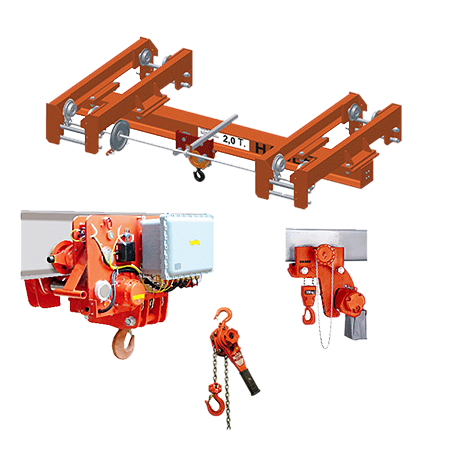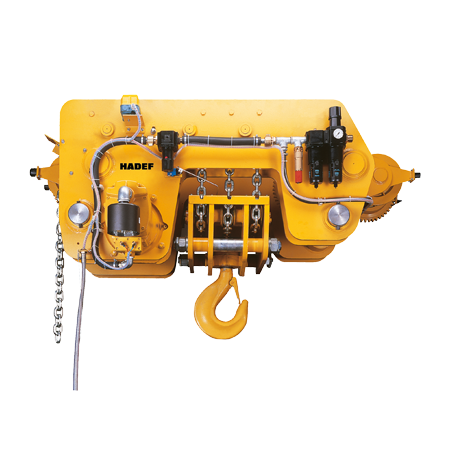The Essential Guide to Hoists, Winches, and Cranes: Revolutionizing Lifting Solutions for Every Industry
INDUSTRIAL SUPPLIES
2/11/20255 min read


Introduction to Hoists, Winches, and Cranes
When it comes to heavy lifting in various industries, hoists, winches, and cranes are indispensable. These machines are used for moving, lifting, and lowering materials with precision and safety. But, despite their ubiquity, understanding the differences, applications, and varieties of these lifting devices can be quite complex. In this comprehensive guide, we will delve into the world of hoists, winches, and cranes, covering everything from their types to the best options for specific needs.
What Are Hoists, Winches, and Cranes?
Before diving into the details of each product, it's important to understand the basic differences between hoists, winches, and cranes.
Hoists: A hoist is a mechanical device used to lift or lower materials using a drum or lift-wheel around which a rope or chain is wound. The main function is to provide vertical movement.
Winches: A winch is similar to a hoist but typically focuses on pulling or hauling heavy objects, particularly horizontally. Winches can also be used for lifting, but their primary design is for winding cables to pull materials over a distance.
Cranes: Cranes are large machines designed for lifting, lowering, and moving materials horizontally. Unlike hoists and winches, cranes often include a system of pulleys and can operate in 360-degree rotations, making them versatile for various tasks in construction and industrial settings.
Types of Hoists: Electric, Pneumatic, and Manual
Electric Chain Hoists
Electric chain hoists are the go-to choice for applications that require powerful lifting capabilities with minimal effort. With an electric motor driving the chain system, these hoists are capable of lifting heavy loads quickly and efficiently. They are often found in industries where high-capacity lifting is needed, such as warehouses, factories, and construction sites.
These hoists are often paired with a control system, allowing the operator to easily maneuver the load up and down at the press of a button. One of the key advantages of electric chain hoists is their ability to operate continuously without much human intervention, which makes them essential for heavy-duty lifting tasks.
Pneumatic Chain Hoists
Pneumatic chain hoists are powered by compressed air, offering a more flexible and efficient lifting solution in environments where electricity may not be available or suitable. These hoists are often used in industries like mining, offshore, and hazardous environments because they don’t pose the risk of sparking, making them ideal for explosive settings.
Pneumatic hoists are known for their reliability, ease of use, and compact design. Their ability to operate in harsh environments without the risk of overheating or causing electrical fires makes them a valuable asset in many industrial applications.
Manual Chain Hoists
Manual chain hoists are the simplest and most cost-effective lifting solution, perfect for smaller tasks or when electricity isn’t available. Operated by hand, the chain hoist requires a user to manually pull the chain to raise or lower the load.
These hoists are widely used in small workshops, garages, and in situations where lifting isn't a frequent need but requires precision and control. While they are not suitable for heavy-duty tasks, manual chain hoists are still crucial in various sectors due to their portability and ease of use.
Manual Chain Hoists with Trolley
For added mobility, manual chain hoists with trolleys are designed to be mounted on a rail system, allowing the hoist to move along the rail with ease. This feature makes them ideal for applications where materials need to be lifted and moved across a specific area, such as in workshops or factories.
The trolley system enhances the manual hoist’s functionality, offering both vertical and horizontal movement in confined spaces. This versatile tool is used in a variety of industries and is available in various sizes depending on the specific needs of the user.
Winches: Versatility for Lifting and Pulling
Wire Rope Winches
Wire rope winches are commonly used in applications where heavy materials need to be pulled over large distances or up inclines. They are commonly found in industries like construction, marine, and mining, where the pulling force is more critical than vertical lifting. These winches use a strong steel wire rope to pull or hoist loads.
Wire rope winches come in different sizes and capacities, allowing operators to tackle projects of varying scale. Their versatility and robust construction make them a staple in industries requiring reliable pulling mechanisms.
Trolleys: The Unsung Heroes of Mobility
Trolleys are often used in conjunction with hoists and winches to provide the necessary mobility for lifting equipment. They are mounted on a track and designed to move loads in both vertical and horizontal directions. Trolleys come in several different forms, including manual, electric, and pneumatic, depending on the system they are used with.
A well-designed trolley system can improve workflow efficiency in many industries, reducing the time and effort it takes to move heavy objects across a workspace.
Cranes: Lifting Power and Precision
Types of Cranes
Overhead Cranes: Often used in factories and warehouses, these cranes are suspended from a ceiling structure and can move loads both horizontally and vertically. They are particularly useful in environments with limited floor space.
Tower Cranes: Commonly used in construction, tower cranes are known for their height and the ability to lift extremely heavy loads. They can rotate 360 degrees, offering unmatched precision and versatility on large construction sites.
Crawler Cranes: These cranes are equipped with tracks instead of wheels, allowing them to move over rough terrain. They are ideal for construction projects that require both mobility and heavy lifting capabilities.
Offshore and Specialized Applications
Offshore Lifting Solutions
In offshore environments, lifting equipment must be able to handle extreme conditions such as high winds, saltwater corrosion, and limited space. Specialized hoists, winches, and cranes are designed to meet the rigorous demands of offshore oil rigs, ships, and platforms. Offshore lifting equipment often features corrosion-resistant materials, additional safety features, and increased load capacities.
Low Headroom Hoists
Low headroom hoists are designed for use in situations where overhead clearance is limited. They provide the same powerful lifting capabilities as standard hoists but are engineered to save space and provide efficient vertical lifting in confined areas. These hoists are particularly useful in warehouses, factories, and other areas where headroom space is a concern.
Special Construction Hoists
For construction applications, special construction hoists are designed to carry materials and personnel up and down multi-story buildings. These hoists are often equipped with enhanced safety features, such as anti-fall systems and emergency stops, ensuring both worker safety and efficiency during operation.
Safety Considerations in Hoist, Winch, and Crane Operations
Safety is paramount when operating lifting equipment. Whether you’re using a hoist, winch, or crane, it’s essential to follow safety guidelines to ensure the safety of workers and the integrity of the equipment.
Key Safety Features to Look For
Overload Protection: Many hoists and winches come with overload protection to prevent lifting beyond their rated capacity. This is a crucial safety feature to avoid accidents or equipment damage.
Automatic Braking: Some hoists and cranes feature automatic braking systems that engage when a load is released, ensuring that the load doesn’t drop unexpectedly.
Safety Cables and Hooks: High-quality safety cables and hooks are essential for maintaining secure lifting. These components are designed to withstand heavy loads and minimize the risk of accidents during operation.
Conclusion
Hoists, winches, and cranes are indispensable tools for lifting and moving heavy materials in various industries. Whether you're dealing with a small workshop or a large construction site, there is a lifting solution tailored to your needs. By understanding the differences between these machines, their specific applications, and safety features, you can make an informed decision when choosing the best lifting equipment for your business.
The right hoist, winch, or crane can revolutionize your workflow, reduce risks, and increase efficiency in your operations. Explore the wide variety of options available and invest in high-quality equipment that will enhance productivity and safety in your workplace.


